1. Introduction
Connect3D X800XT PE - 01 - Introduction
Connect3D is a manufacturer of graphics cards for the PC industry
and a long time certified partner of ATI. From the Radeon 7000 to the latest
X800 powered cards, Connect3D has always been present with competitive prices,
top-notch products and excellent support.
- Packaging
The card ships as part of a minimal package for a graphics card.
Connect3D wastes no space and the card along with the bundled accessories,
all fit snuggly inside the rather compact packaging, something that probably
helps keep the final price of the product down to an absolute mininum.
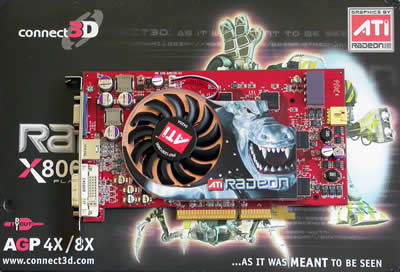
- Bundle
Apart from the ATI Radeon Driver CD, there is no other software
bundled with the X800XT. This is not a disadvantage in this case as Connect3D's
primary concern was to keep the price of the card low so as to make it more
affordable for gamers.
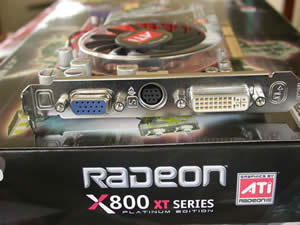
Inside the box, you will find a VGA to DVI-I connector for Dual
monitor support, an S-Video cable, an S-Video to composite video adapter,
an HDTV to composite video and finally a composite cable.
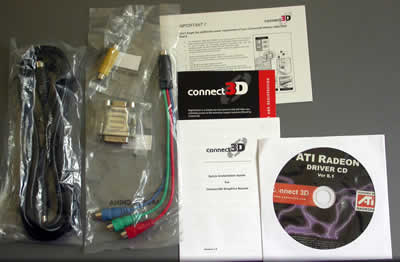
2. Features
Connect3D X800XT PE - 02 - Features
| Main Features |
| GPU |
Radeon X800 XT PE - R420 |
| Memory Brand/Model |
Samsung K4J5532QF-GC16 |
| Memory Type |
256 MB 256-bit GDDR3 |
| Engine Clock Speed |
520MHz |
| Memory Clock Speed |
560MHz (1.6ns) |
| Memory Bandwidth |
35.8 GB/sec |
| Pixel Pipelines |
16 |
| Shader Pipelines |
6 |
| Fill rate |
8.3 Giga pixels /sec |
| DX Support |
9.0 |
| OpenGL Support |
1.5 |
| Output |
VGA / DVI-I / D-Sub |
| Bus |
AGP 4X/8X |
| Processing technology |
0.13 micron |
Connect3D's X800XT Platinum Edition is based on ATi's R420 chipset which is
built using the 0.13 micron process. The card's engine clock ticks at 520MHz
and the Memory clock at 560MHz, reaching the effective speed of 1.12GHz. The
differences between the three available versions of the X800 can be seen in
the table below.
|
X800 PRO |
X800 XT |
X800 XT PE |
| Core(MHz) |
475 |
520 |
520 |
| Memory(MHz) |
450(900) |
520(1040) |
560(1120) |
| Pipelines |
12 |
16 |
16 |
You can see the only thing that seperates the XT PE from a simple XT version
is the slightly higher clock speed.
The 256-bit memory bus on the X800, halves the amount of time the GPU has to
idle in order to pass data back and forth to the memory. The 16 pixel pipelines
inside the X800 engine, contribute to the card's great performance as the calculations
needed for the very demanding games of our time will take much less time.
 |
| X800 Architecture |
Also note that the card can operate in both 4x and 8x mode making it compatible with older motherboards.
3Dc
To understand what 3Dc does, we need to step into a brief discussion about
normal maps.
You can think of a normal as an arrow pointing outwards from a surface at a
90 degree angle in order to quickly access its angle difference from different
points of lighting.
First, a model with an extremely high polygon count is created (i.e 15000 polygons)
and then one with less (1000 polygons) and that is the one that we'll eventually
keep. Running a simple program calculates the differences between the two models
and stores it as a normal map texture. Before rendering the final model in the
game, the normal map texture is applied on the low polygon model and pixel shader
instructions are used to compute real time lighting.
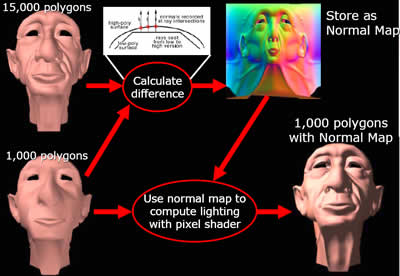 |
| A quick example of Normal Mapping (not 3Dc!) |
Normal mapping is greatly used in some of the most successful
game titles of our days like Far Cry, Half Life 2 and Doom 3. However, the problem
with Normal mapping is the great limitation to the texture size due to the lack
of compression.
To get a peek at what would happen if none of the textures were
compressed in a recent game, try Doom 3 and set the details to Ultra High. As
suggested by Id Software, Doom3's publisher, the Ultra High detail level requires
a graphics card with 512Mb RAM. In case you're not really into the graphics
card market there is no card with 512Mb RAM, yet.
Such is the case with normal mapping. The current texture compression algorithms DXTC and S3TC are inapplicable on normal mapping textures as they produce block artifacts, so programmers usually avoid using them.

3Dc is the solution to this problem with an algorithm that splits
up the texture into blocks. Then compressing each block, it is able to achieve
up to 4:1 compression.
 |
When using 3Dc you can get much better quality textures with the same performance from your card. |
The bad thing about 3Dc is that we'll have to wait until the game developers
incorporate it into their engines or release a patch that takes advantage of
it. Ubisoft was supposed to be the first to include 3Dc support into their much
awaited Far Cry patch 1.3. However, as we found out, there is no actual difference
in the game despite the addition of the console command "EnableCompressedMaps".
3. A closer look
Connect3D X800XT PE - 03 - A closer look
The memory components on the Connect3D are the very popular
K4J55323QF-GC16. The GC16 stands for the 1.6ns delay between memory transactions.
 |
| One of the Samsung 1.6ns memory parts |
The standard ATi X800 minotaur is printed on the fan-sink indicating
the card's power:
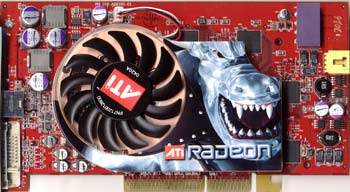 |
| The front side of the card.(click for hi-res). |
One thing to note here, is that unlike other X800 cards, the
fansink on the Connect3D X800XT PE doesn't cover the memory chips. There exists
an alternate version of this fansink, similar in shape but a bit larger, like
the one we saw on our Asus
X800XT review.
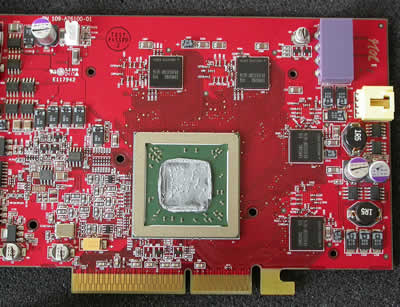 |
| Removing the fan exposes the GPU core. |
From the picture above, you can clearly see the molex power
connector. If you forget to connect your power supply on to the card, the
system speaker will beep during the BIOS POST and prompt you to connect it
in order to boot.
 |
| The R420 chipset cleaned up from the thermal paste. |
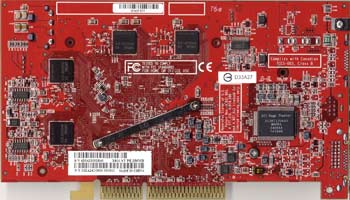 |
| The back side of AX600XT (click for hi-res) |

The card features 3 types of connectors on the rear. One for
VGA output, where you can plug in your standard CRT monitor, a DVI output
for TFT monitors and an S-Video for Video In and Video Out use.
4. Test System
Connect 3D X800XT - 04 - Test System
Processor:AMD FX-55
Case: Antec 1080AMG
Motherboard: Asustek A8V
Memory: 2x512MB OCZ PC-4200 Memory
Hard Disk Drive: WD800JD 80GB 7200RPM
CD-RW: LiteOn LTR-52246S
PowerSupply: Levicom 500Watt
Microsoft WindowsXP Pro SP2
DirectX v9.0c
Benchmarking Software
3DMark05,03,01
Codecreatures Benchmark Pro
AquaMark3 v3.0
ATiTool 0.0.22
Farcry v1.3
CounterStrike Source
Doom 3
Medal of Honour Pacific Assault Demo
Thief 3
Ground Control II

5. 3DMark05
Connect 3D X800XT - 05 - 3DMark05
 With 3DMark05, Futuremark continues the tradition in its benchmarking software by providing a state-of-the-art Microsoft ® DirectX ® 9 3D performance benchmark.
With 3DMark05, Futuremark continues the tradition in its benchmarking software by providing a state-of-the-art Microsoft ® DirectX ® 9 3D performance benchmark.
3DMark05 is an all new 3DMark version taking the most out of Microsoft's DirectX
9. The previous version 3DMark03, did a nice introduction into this level
of technology. However 3DMark03 used DirectX 9 specific features in a limited
manner, because fully supporting  hardware
was rare at the time of its launch. In contrast, 3DMark05 requires DirectX
9 hardware with full support for at least Shader Model 2, and takes shader
usage to never before seen levels.
hardware
was rare at the time of its launch. In contrast, 3DMark05 requires DirectX
9 hardware with full support for at least Shader Model 2, and takes shader
usage to never before seen levels.
Just like its predecessors, 3DMark05's point system is set so that at the
moment of release, the high-end VGA cards available in stores can only score
around 5000 3DMarks, whereas the worst card that meets the programs requirements
yields a score of 1000.
Game Test 1 -Return to Proxycon
Being the sequel to the "Battle of Proxycon"
from 3DMark03, in "Return to Proxycon" we're once again set in space
and the battle continues as space pirates invade a cargo ship in order to
take control of its valuable cargo.

This test, tries to simulate a future first-person shooter game with all the high details that entails. The dynamic shadows, high-detailed environment and advanced lighting techniques ensure that under normal circumstances, no recent card can run it with decent frame rates.
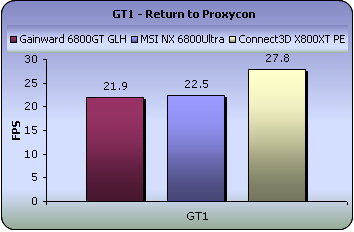
Very impressive start for the ATI card. It easily surpassed
both 6800's with 5fps difference.
Game Test 2 – Firefly Forest
A forest gets filled with magic fireflies in the night. The moon is nearly full, illuminating the forest with a bluish faint light. The magic fireflies have flickering bright green lights that playfully move around the forest.
This scene is a nice example of a smaller scale outdoor scene with rich vegetation. Immediate visibility is not so far, and there is a skybox surrounding the whole scene.
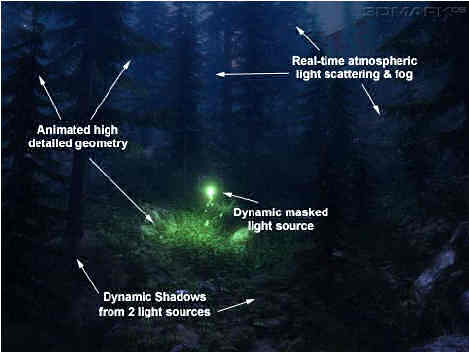
A large number of trees with their branches swinging separately, and dense vegetation being dynamically distributed according to the camera movements, make this test the most demanding of the three.
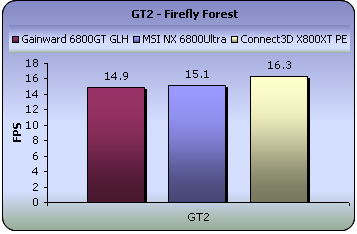
All three cards here had a hard time rendering the game test
as the complexity of lighting kept the scores at low levels. However, the
Connect3D X800XT stands out by an average of 1fps.
Game Test 3 – Canyon Flight
A Jules Verne type airship flies through a canyon guarded by a dangerous sea monster. The airmen
defend their ship using heavy cannons, but these seem to have no effect on the huge sea monster.
Finally the crew manages a narrow escape using the ‘last resort’ afterburners of the airship.
This scene is fairly complex with large areas of
water reflecting the high canyon walls. The water actually is one of the key points of interest in this scene.
The water not only does realistic looking reflections and refractions, it has a depth fog, making the sea
monster swimming under the airship actually look deep down in the water. The air in this scene also uses
a volumetric fog, making distant cliffs of the canyon really look far away.


The Connect3D X800XT framerate almost reached 30 with both 6800s
following behind at around 27fps.
Final Score
3DMarks on 3DMark05 are now calculated by the following formula:
(Game Test 1 * Game Test 2 * Game Test 3)^0.33 * 250
That’s basically the geometric mean of the total frames
in each game multiplied by 250. This means that all game tests are now equal.
Let’s see our result for X800XT:

The result reflects exactly what we saw in the seperate game
test. The Connect3D X800XT was superior than its competitors whereas the two
6800 cards performed almost identically.
6. 3DMark 2003
Connect 3D X800XT - 06 - 3DMark 2003
 3D Mark is a widely used and accepted benchmark that stresses the DirectX performance of a VGA card. A very strong point of 3DMark is that it's VGA card measuring is does not require any CPU power. So the resulting fps are a good reference a VGA card's rendering performance. For testing the performance of each card we used the 4 game benchmarks 3DMark has.
3D Mark is a widely used and accepted benchmark that stresses the DirectX performance of a VGA card. A very strong point of 3DMark is that it's VGA card measuring is does not require any CPU power. So the resulting fps are a good reference a VGA card's rendering performance. For testing the performance of each card we used the 4 game benchmarks 3DMark has.
3Dmark03 also includes sound and CPU tests as well as some other feature tests.
- Game Test 1 - Wings of Fury (DX7)
 This test is a combat flight simulator written for older hardware (DirectX 7). Particles are used a lot in this test - smoke and vapor trails, flak and gunfire, and explosions are produced using point sprites and quads.
This test is a combat flight simulator written for older hardware (DirectX 7). Particles are used a lot in this test - smoke and vapor trails, flak and gunfire, and explosions are produced using point sprites and quads.
- Game Test 2 - Battle of Proxycon (DX8)
 This test is a simulation of first person shooter game types. 1.1 and 1.4 Vertex shaders are widely used since all character models are skinned using vertex shaders.This makes this test a good vertex shader comparison for VGA cards.
This test is a simulation of first person shooter game types. 1.1 and 1.4 Vertex shaders are widely used since all character models are skinned using vertex shaders.This makes this test a good vertex shader comparison for VGA cards.
- Game Test 3 - Trolls' Lair (DX8)
 This test should be the favorite of all RPG lovers. It is a cut scene of a female warrior facing two malicious trolls. Again the same vertex and pixel processing is used as in game test 2.
This test should be the favorite of all RPG lovers. It is a cut scene of a female warrior facing two malicious trolls. Again the same vertex and pixel processing is used as in game test 2.
This test also uses post-processing effects, such as Depth of Field and Bloom effects which are widely used in today's game cut scene sequences.
- Game Test 4 - Mother Nature (DX9)
 Mother nature represents the level of effects and realism that are possible using 2.0 vertex and pixel shaders, plus some other features that DirectX 9 offers.
Mother nature represents the level of effects and realism that are possible using 2.0 vertex and pixel shaders, plus some other features that DirectX 9 offers.
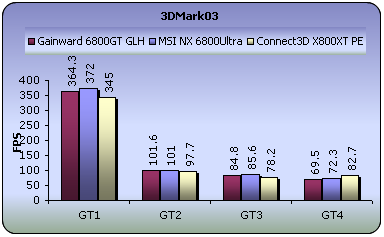
The results from 3DMark03 at first glance differ from what we
saw with 3DMark05. The X800XT's performance was worse on the first three games
and that shows lack of power running DX7 and DX8.1 games. However, on Game Test
4 which is based on DX9 code, the ATI card took the lead by more that 10fps.
- 3DMark Official score
If you test your machine with 3DMark you can post the results at 3DMark' online result browser. For more information visit futuremark.com.
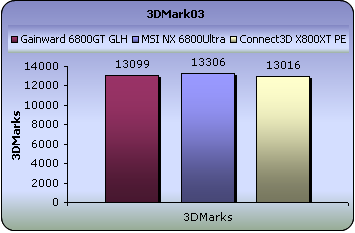
It seems X800XT's performance on the last game could not make up for the smaller framerates that the first few game tests. The card finished last in line but note that the differences between the scores are small and insignificant.
7. Aquamark3 / 3DMark 2001
Connect 3D X800XT - 07 - Aquamark3 / 3DMark 2001
 Since the majority of today's applications and games are compatible with DirectX 9, the need of benchmark applications that use DX 9 has been brought up. The benchmark uses the 3D engine (Krass engine) of the Aquanox game.
Since the majority of today's applications and games are compatible with DirectX 9, the need of benchmark applications that use DX 9 has been brought up. The benchmark uses the 3D engine (Krass engine) of the Aquanox game.
Aquamark Triscore
The Aquamark Triscore comprises 3 values: the overall system performance, the performance of the graphics system and the CPU performance. Keep in mind that this is not the total result of the tests, but the result of the whole benchmark process including all 9 chapters.

3DMark 2001
3DMark 2001 is the predecessor to 3DMark03. It's mainly a directx8.1 benchmark and the score depends a lot on the CPU power of your computer. However for reference use only we decided it'd be best to just leave it in our benchmark list so you can compare the next generation cards with the possibly outdated you have at home.

8. Codecreatures
Connect 3D X800XT - 08 - Codecreatures
 CodeCreatures is a synthetic 3D benchmark that is a good reference for VGA performance comparison. This is a high-end 3D benchmark that also requires DirectX 8 hardware, making a good tool for measuring the potential of DirectX 8 game performance.
CodeCreatures is a synthetic 3D benchmark that is a good reference for VGA performance comparison. This is a high-end 3D benchmark that also requires DirectX 8 hardware, making a good tool for measuring the potential of DirectX 8 game performance.
The Codecreatures benchmark is written with Microsoft's DirectX 8.1 API and incorporates the use of Vertex and PixelShaders popular on next generation 3D accelerators.
 The benchmark plays a photo-realistic nature scene and calculates the performance of the graphics adapter by measuring the fps that it can display at 1024x768, 1280x1024 and 1600x1200 resolutions.
The benchmark plays a photo-realistic nature scene and calculates the performance of the graphics adapter by measuring the fps that it can display at 1024x768, 1280x1024 and 1600x1200 resolutions.
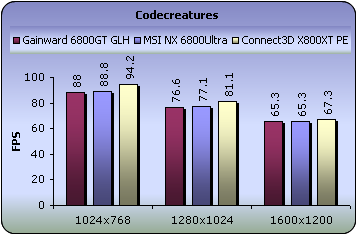
-Codecreatures number
The codecreatures number is the resulting score of the total benchmarking process and is basically the geometric mean of the three framerates multiplied by 100.
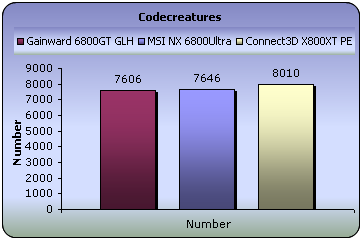
The X800XT PE Connect3D card managed to surpass 8000 as the card
seemed to do a great job of rendering Codecreatures virtual world under all
resolutions.
9. Half life 2
Connect 3D X800XT - 09 - Half life 2
Half life 2 is no doubt the most anticipated pc game of all times. Gamers keeping the excellence of Half Life 1 in their mind as well as the remarkable E3 demo preview, have been anxiously waiting for the much delayed release of HL2.
 Regarding the storyline, the player again picks up the crowbar of research scientist Gordon Freeman, who finds himself on an alien-infested Earth being picked to the bone, its resources depleted, its populace dwindling. Freeman is thrust into the unenviable role of rescuing the world from the wrong he unleashed back at Black Mesa. And a lot of people he cares about are counting on him.
Regarding the storyline, the player again picks up the crowbar of research scientist Gordon Freeman, who finds himself on an alien-infested Earth being picked to the bone, its resources depleted, its populace dwindling. Freeman is thrust into the unenviable role of rescuing the world from the wrong he unleashed back at Black Mesa. And a lot of people he cares about are counting on him.
Characters - Advanced facial animation system delivers the most sophisticated in-game characters ever seen. With 40 distinct facial "muscles," human characters convey the full array of human emotion, and respond to the player with fluidity and intelligence.
Physics - From pebbles to water to 2-ton trucks respond as expected, as they obey the laws of mass, friction, gravity, and buoyancy.

Graphics - Source’s shader-based renderer, like the one used at Pixar to create movies such as Toy Story® and Monster's, Inc.®, creates the most beautiful and realistic environments ever seen in a video game.
AI - Neither friends nor enemies charge blindly into the fray. They can assess threats, navigate tricky terrain, and fashion weapons from whatever is at hand.
 To measure performance we used the Video Stress Test(VST) that is available in the CounterStrike:Source beta available through Steam. We set all the details to the highest level and each time changed the resolution from 800x600 up to 1600x1200.
To measure performance we used the Video Stress Test(VST) that is available in the CounterStrike:Source beta available through Steam. We set all the details to the highest level and each time changed the resolution from 800x600 up to 1600x1200.

Some months ago, ATi cards were thought to be the perfect choice
for Half Life 2 whilst NVIDIA cards were said to perform poorly when rendering
the Source engine. However the new generation of NVIDIA cards, the GeForce
6, seem to shake the ground, straight out outperforming the best ATi chipset
available on the market.
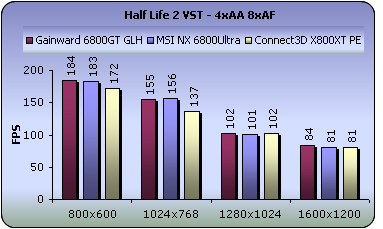
Enabling the quality options (Anisotropic Filtering and Anti
Aliasing) for Half Life 2, the gap between the X800 and 6800 is still there
but begins to diminish and finally reaches an equillibrium with the last two
resolutions where all cards perform equally well.
10. Doom 3
Connect 3D X800XT - 10 - Doom 3

A massive demonic invasion has overwhelmed the Union Aerospace Corporations? (UAC) Mars Research Facility leaving only chaos and horror in its wake. As one of the few survivors, you struggle with shock and fear as you fight your way to Hell and back, in an epic clash against pure evil.
Activision made it's miracle again with Doom 3 which is said to be the best-looking game ever, thanks to the brand-new OpenGL graphics engine used to generate its convincingly lifelike, densely atmospheric, and surprisingly expansive environments. If you are a fan of the previous Doom games then you will get many flashbacks with this revision, since you will find reimagined versions of almost every monster from both Doom and Doom II.

To measure performance on the game we used the timedemo demo1 command from the console (Alt+Ctrl+~).
Enabling the high quality setting and executing the timedemo demo1 command twice for each resolution, we witnessed the following:
First, without the Anti-Aliasing and Anisotropic Filtering settings
enabled, we got the following results:
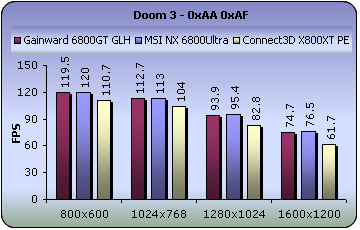
Unlike Half Life 2, the rumours about Doom 3 proved to be true.
ATi cards lack in OpenGL the power to render Doom 3 appropriately and fall
behind when compared to their NVIDIA counterparts.
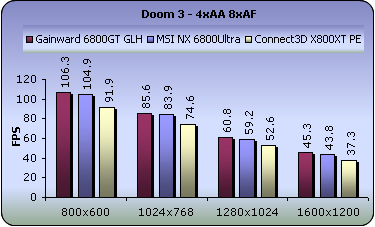
Enabling Anisotropic Filtering and Anti Aliasing, we get the
same results. The difference ranges from 5 to 13fps which is quite disappointing.
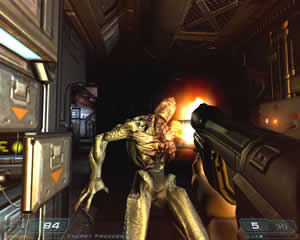
11. Far Cry
Connect 3D X800XT - 11 - Far Cry

 You are Jack Carver running your own boat charter business in beautiful Micronesia. With a past best left behind you, you'll be focusing on your present assignment: escorting an ambitious journalist named Valerie Cortez to the Island of Cabatu. It seems like a piece of cake, but you'll soon learn: paradise can be hell.
You are Jack Carver running your own boat charter business in beautiful Micronesia. With a past best left behind you, you'll be focusing on your present assignment: escorting an ambitious journalist named Valerie Cortez to the Island of Cabatu. It seems like a piece of cake, but you'll soon learn: paradise can be hell.
Farcry is an awesome First Person Shooter (FPS) based on a last generation 3D engine named as CryEngine. Real-time editing, bump-mapping, static lights, network system, integrated physics system, shaders, shadows and a dynamic music system are just some of the state of-the-art features that the CryEngine offers.
A great advantage and strong point of the CryEngine is its physics system which supports character inverse kinematics, vehicles, rigid bodies, liquid, rag doll, cloth and body effects. All physics seem to be very realistic and you never get bored when facing enemies, since character models have multiple animations that blend in believable ways.
With an integrated shader system and a massive terrain which maximizes
the view distance to 2km, these features make Farcry a perfect action game and
also a referable benchmark to speak of.
- Benchmark Settings
For this game we recorded a new demo from the start of the Rebellion
stage. We chose an indoor scene in order to avoid being CPU bound under any
circumstances. This will produce slightly higher results since it is also less
GPU intensive, but we can't afford being stuck at 40-50 fps because of our CPU.

The latest patch (1.2) was used for our tests which updates the
game's graphics engine to use the 3.0 Shader model. Unfortunately, this is supported
for the 6800 series only.
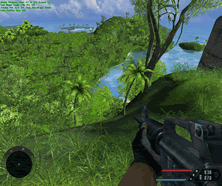
The resolutions we run the demo under, are the following: 800x600,1024x768,
1280x1024 and 1600x1200. The first test was committed with Anti Aliasing (AA)
and Anisotropic Filtering (AF) features off. In the second test we leveled up
AA to 4x and AF to 8x. All tests were taken with Jack's flashlight on, to increase
the game's requirements on the graphics cards.

The Connect3D X800XT PE seems an excellent choice for a game like
Far Cry. It had no problems rendering up to the incredible rate of 150 frames
per second under 1024x768 resolution.

Increasing the quality of the game with AF and AA, we get a drop
of approximately 20% but the cards still hold the framerates at a satisfactory
level even at the highest resolution.
12. Medal of Honour Pacific Assault
Connect 3D X800XT - 12 - Medal of Honour Pacific Assault
 Medal of Honor Pacific Assault puts you in the boots of a WWII soldier in the Pacific Theater of Operations. As Marine Private Tommy Conlin, you
Medal of Honor Pacific Assault puts you in the boots of a WWII soldier in the Pacific Theater of Operations. As Marine Private Tommy Conlin, you  must survive the devastating attack on Pearl Harbor and then join the Allied crusade to defeat imperial Japan's bloody conquest of the Pacific. From the attack at Pearl Harbor to the pivotal battle against Japanese Forces at Tarawa Island, Medal of Honor Pacific Assault gives PC gamers a sense of the courage it took to endure and overcome the Japanese threat in WWII and fight for VICTORY in the Pacific.
must survive the devastating attack on Pearl Harbor and then join the Allied crusade to defeat imperial Japan's bloody conquest of the Pacific. From the attack at Pearl Harbor to the pivotal battle against Japanese Forces at Tarawa Island, Medal of Honor Pacific Assault gives PC gamers a sense of the courage it took to endure and overcome the Japanese threat in WWII and fight for VICTORY in the Pacific.
To record performance of this game we used fraps and played around for a minute in the first stage of the demo.
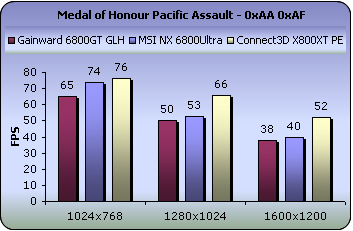
Medal of Honour Pacific Assault (MoHPA) is a very demanding
game when it comes to graphics rendering power. Even top-notch graphics cards
such as the X800XT and 6800U seem to have trouble with it when the resolution
is set to a high level, such as 1600x1200. However, the X800XT stands out
of the crowd a bit, with a difference of around 10fps.

13. Thief 3
Connect 3D X800XT - 13 - Thief 3
 Instead of Deus Ex from now on we’ll be testing our cards using Thief 3. It’s based on the same engine but it’s much less GPU intensive and playable by more VGA cards than Deus.
Instead of Deus Ex from now on we’ll be testing our cards using Thief 3. It’s based on the same engine but it’s much less GPU intensive and playable by more VGA cards than Deus.
The game makes severe use of Pixel Shader 1.1 instructions, the bloom effect and stencil shadows to achieve a wonderful result in your screen. 
In the game you play the part of Master Thief Garrett who is back to rule out any evil forces using his unique stealth abilities. Deadly Shadows shows what stealth gameplay is all about. This game really gives you the feel of sneaking around and holding your breath when stuck in a sticky situation.
Since there is no official benchmark for the game, we’ll do our tests using a GPU intensive scene from the tutorial-level which we believe that represents the average fps you’ll get when playing the game.
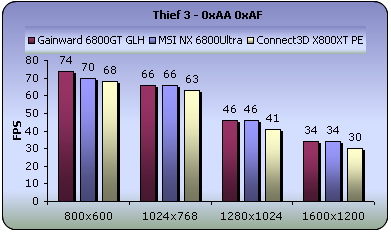
All cards seem to face difficulties running this game. The framerates are really low and hardly acceptable at 1600x1200, even with performance beasts such as our X800XT and 6800Ultra.
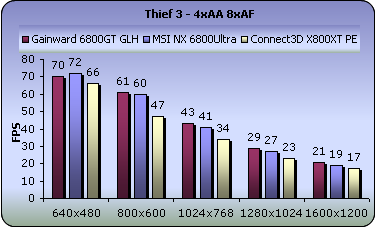
Enabling 4x Multisampling and 8x Anisotropic filtering makes the
game unplayable at high resolutions. The best compromise between quality and
performance is running the game at 1024x768 (provided that your monitor is 17"
or less).
14. Colin McRae 05
Connect 3D X800XT - 14 - Colin McRae 05
 For all you racing fans out there, this test is for you and will represent the Racing game category in our benchmarks.
For all you racing fans out there, this test is for you and will represent the Racing game category in our benchmarks.
From the graphics point of view the first thing you’ll notice in the game is the excellent amount detail of your racing car. High resolution textures on the car and lighting make it quite impressive. All the eye candy such as the sun reflection in the virtual camera are still the same as the older CM versions but motion blur has been added when your card hits something hard which will happen most often if you're new to the racing simulation world.
To measure performance on the game we used fraps to get the average fps of the whole 8th stage of UK which is actually the only stage you get to play on the demo.
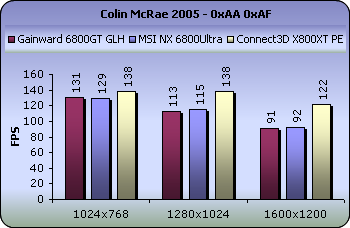
You can see that under 1024x768 and 1280x1024, the resulting
framerates for the Connect3D X800XT PE are equal because of the performance
being restricted by our CPU (AMD FX-55).
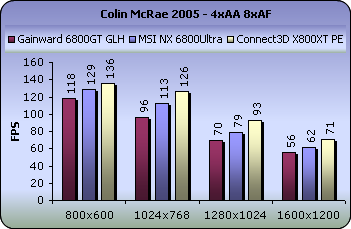
Even at the highest quality settings, performance is still excellent
with all the cards. However, the Connect3D card managed to stay on top under
all circumstances.

15. Ground Control II
Connect 3D X800XT - 15 - Ground Control II
 Ground Control 2 is an action-oriented game of tactics and warfare. As Captain Jacob Angelus of the Northern Star Alliance, you will command squads of infantry, artillery, and airpower against the might of the Empire of Terra. Base building and
Ground Control 2 is an action-oriented game of tactics and warfare. As Captain Jacob Angelus of the Northern Star Alliance, you will command squads of infantry, artillery, and airpower against the might of the Empire of Terra. Base building and  resource-collecting are replaced with unit control and combat tactics where your knowledge of the battlefield maneuvers will make the difference in your fight against a ruthless enemy. Position your troops on hilltops for better aim or inside buildings and forests for protection as you’ll need to use every inch of terrain to your advantage. Call in air strikes or assault pods to bring the battle behind enemy lines. Send out scouts to locate the enemy and use spotters for your artillery with the 360° free-roaming camera. Experience the total immersion of futuristic warfare as you lead your forces to victory!
resource-collecting are replaced with unit control and combat tactics where your knowledge of the battlefield maneuvers will make the difference in your fight against a ruthless enemy. Position your troops on hilltops for better aim or inside buildings and forests for protection as you’ll need to use every inch of terrain to your advantage. Call in air strikes or assault pods to bring the battle behind enemy lines. Send out scouts to locate the enemy and use spotters for your artillery with the 360° free-roaming camera. Experience the total immersion of futuristic warfare as you lead your forces to victory!
For our benchmarks, we used the highest possible settings on the first mission
of the single player game and moved around the camera to get an average framerate
using fraps.
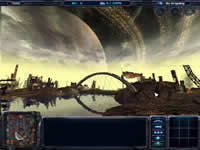
Ground Control II offers really impressive graphics without requiring much GPU power. Click on the picture above to view a screenshot from the game. Check out these excellent water effects!

All cards start out at 800x600 with similar performance as we're
limited by our CPU. From that point on, the Connect3D card seems to fall behind
the 6800's but still the framerate is kept at respectable levels.

The same situation remaing in this chart. Enabling Anisotropic
Filtering and Anti Aliasing makes the cards lose more than 50% of their previous
performance and the X800XT especially falls down to 32fps under 1600x1200.
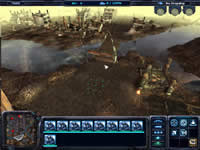
16. Overclocking
Connect 3D X800XT - 16 - Overclocking
No matter your graphics card, there comes a time in your computer's life when it can no longer cope with the latest technology the ever so popular games use. This is one of the main reasons for overclocking your graphics card. Gamers are always looking forward for a little extra boost in terms of framerate. Even though most of the times the boost is far from noticeable, overclocking remains the last resort when you can't afford to buy a brand new VGA card.
 |
Increasing the memory clock too much,
produces the so-called "artifacts". |
As we mentioned earlier, the default clock speeds of the Connect3D X800XT PE
are 520MHz for the core and 560MHz for the memory. Using ATITool, we succeeded
in overclocking the card to 535MHz and 600MHz (1.2GHz) respectively.
Let's see the impact this had with three of our most popular benchmarks.
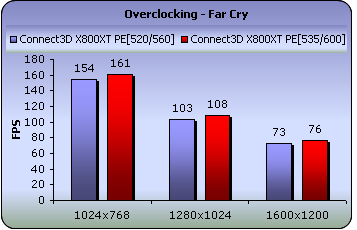

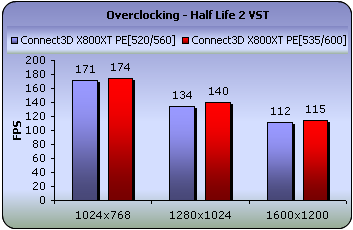
The difference in the games varied from 2 to 7 fps. Surely nothing
exciting, but if the card can handle it with its stock standard cooling, then
every little performance gain is welcome.
17. Conclusion
Connect 3D X800XT - 17 - Conclusion
The performance of the Connect3D X800XT PE raises an issue. Is this card better
than the 6800Ultra or not? The benchmarks are a bit confusing. Some favour the
ATi card while others favour the NVIDIA cards. Here's a sumup:
3DMark05,3DMark01, Aquamark03, Colin McRae 05, Codecreatures, Far Cry, Medal
of Honour all point to the X800XT, whereas Doom 3, Half Life 2, Ground Control
II, 3DMark03 and Thief 3 to the 6800's.
You can see that with the majority of our benchmarks, the X800XT did much better
than its competitors but we can't just ignore Doom 3 or Half Life 2. It's all
up to you in the end and what you are looking for in a graphics card: generally
great performance for the games to come or just excellent performance in a game
or two of your choice.
The Connect3D X800XT PE costs around $500 (USD). Bringing that factor to the
comparison against the 6800GT from Gainward ($550) and the 6800 Ultra from MSI
($600), we believe ATi earns some strong points.
To cut the costs to the minumum, we remind you once again that Connect3D includes
no bundled software along with it's X800XT PE. Those of you who are looking
for some bonuses when buying a graphics card, well this card is probably not
for you.

Pros:
-Excellent performance with most of the games.
-Acceptable price for the average enthusiast.
Cons:
-No software bundle
Performance: |
|
Value for money: |
|
Overclocking: |
|
Bundle: |
|